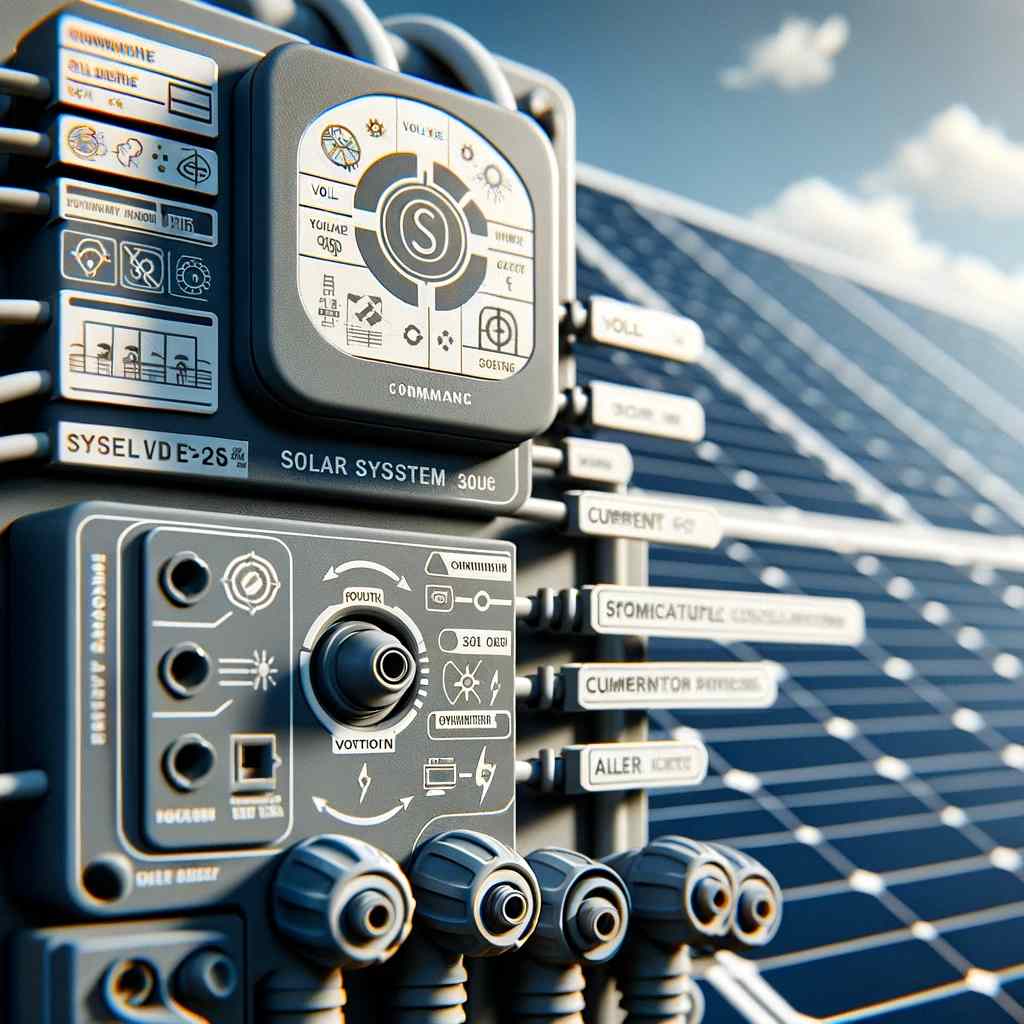Imagine you just bought a solar power system. There’s the excitement of finally being part of the sustainable energy community, and then, suddenly, it hits you… “What do all these labels mean?” Don’t sweat! I’ve got your back!
Importance of Labelling in Solar Power Systems
Let’s kick things off by addressing the elephant in the room: why do solar power systems even need labels? Just like ingredients labels on a can of soda let you know what you’re drinking (and tries to make fructose sound fancier than it is), solar system labels give detailed information about what’s under the hood. Solar power systems are carefully assembled blends of tech, wires and numbers – understanding them through labelling can save you headaches down the line.
Safety Considerations in Solar Power Systems Labelling
Plus, keeping things safe is another biggie when it comes to labels. Imagine attempting a mean lasagna recipe without knowing which part of the oven heats and which part is safe to touch – escapades into amateur spaceship construction aside, that knowledge can be pretty crucial, wouldn’t you say? Similarly, correct labeling in solar power systems lets everyone from installers to maintenance staff know what they’re dealing with and how to approach safety measures.
Understanding the Context for Solar Power System Labels
I’m sure you’ve noticed this at some point: two items that look exactly alike but have different uses or functions. Kinda like those celebrity look-alikes, right? Now imagine how puzzling it would be if your solar panel and crisp flat-screen TV had no identifying details! Labels provide context, helping you distinguish your solar power gear from everyday electronics, clarifying installation contexts, and making sure things are placed where they belong – in the sun!
Brief History of Solar Power Systems
Let’s take a fun little jaunt through time! Did you know that the concept of catching some rays for power is older than the internet? In fact, it’s ancient! As early as 7th Century B.C., people used magnifying glasses to concentrate the sun’s rays for – you guessed it – making fire. Fast forward to today, we’ve upgraded from fire-making to powering entire households. Who knows, maybe someday we’ll even charge our hoverboards with solar power!
Growth and Development of Solar System Standards
The standards for solar systems have evolved too, along with technology and efficiency. Like how video games progressed from 8-bit wonders to modern day realistic visuals (seriously, how did Mario survive without lifelike textures?!), solar power has come a LONG way. Labels have grown more complex, incorporating vital standards to ensure safety and performance.
Types of Solar Power Systems
Solar power systems aren’t one-size-fits-all (disappointing, I know). It’s like ice cream flavors – you’ve got plain old vanilla for traditionalists, and then more “exotic” ones like cookies and cream or matcha for the adventurous souls out there. In the realm of solar power, we’re talking grid-tie systems that work alongside the utility grid, hybrid systems adding batter storage to that mix, and off-grid systems aimed at full autonomy – fully breaking up with ‘the grid’. Understanding these types leads us halfway through deciphering labels on our solar abundance machines.
Purpose of Labels in Solar Power Systems
Lets round it off with honing in to the purpose of these labels on solar power systems. If our solar devices could talk, labels would be their language – describing elements, instructing usage, conveying warnings and assuring us of their conformity with standards. They’re not just irritating stickers that refuse to come off – they’re complex conversations imprinted onto your system. So next time you see one, smile and wave – you’re about to engage in a fascinating chat!
So we’ve covered some basis on why labels exist, the importance of safety, a fun little throwback through history, talked about standards and the variety available, and rounded off with a bit on the purpose of things…
The Different Types of Labels
Let’s jump back in, but this time diving into labels’ types on solar power systems. It’s like ordering at a burger joint – they’ve got the works, the regular, and maybe even the ‘not-so-hamburger’. In solar systems, you’ve got labels that offer warnings, ratings, identification, and certification. Each provides a chapter in the thrilling saga of your solar system’s story.
Design and Color Codes Used
It wouldn’t be fair to talk about labels without mentioning their colorful (quite literally) visuals. Like how we appreciate Van Gogh for his unique color palette, colors used in solar labels provide valuable communications often quicker than words. Red screams imminent danger to components or people (you wouldn’t want to mess with that!), Yellow hints caution required while blue tag quietly communicates instructions without being too bossy.
Understanding the Graphics on Labels
Labels on solar systems aren’t just word-heavy; they come with their share of geometry lessons too. Much like how road signs use universal symbols to guide drivers or let them know there may be deer eager to cross their path in next 1000 meters or so, label graphics give clear, cross-language signals relative to electricity or radiation associated with our friendly neighborhood sun!
Decoding Text Information on Labels
Moving away from graphical delights for a bit, let’s focus on words. The text present on solar labels is like cliff notes summarizing the entire plot twist of your favorite thriller novel. Deciphering it can help flawlessly understand technical specifications, voltage ratings, manufacturer codes and lot more about solar systems. Suddenly it feels much like mastering a new language, doesn’t it?
Warning Symbols and Their Meanings
Among the labels cast, warning symbols play a pretty significant role. They are like the super-villain’s ominous background music in your favorite superhero flick, letting you know to brace for potential danger. These symbols help avoid mishaps during installation/maintenance and ensure the safety of all who dare venture near your shiny energy converter.
International Standards for Solar Power System Labelling
As our lives grow increasingly global (thank you, internet), it’s comforting to know there’s continuity in how solar power systems are labeled worldwide. It’s sort of like finding out that laughter is universally understood – it just feels warm n’ fuzzy inside! These standards ensure that system information remains consistent whether the solar panel is basking under the Moroccan sun or weathering a snowstorm in Alaska.
Role of National Electrical Code (NEC) in Labelling
Last but not least, let’s introduce another big player – the National Electrical Code. Much as pizza without cheese would be plain redundant (and slightly odd), labeling without adhering to NEC guidelines would arguably risk making those labels decorative stickers instead of informative tools they’re meant to be. NEC provides specific instructions for information included on labels and where those labels need to be placed on your system.
And whew! You’ve just survived round 2 in our ‘Let’s Label’ journey. We dwelled upon label types, their color codes and designs, understanding graphics and text information along with warning symbols hidden beneath cryptic disguise. Wrapped up with some knowledge about international standards as well as a peek into NEC’s role in labeling…
Key Requirements for Residential Solar Power System Labels
Journeying on, let’s explore what labelling regulations dictate for residential solar power systems specifically. Just like you’d have different rules leading a rock band versus managing a string quartet (one probably involves fewer guitar smashes), the specifications vary when the stage is a home instead of a commercial building. Regulations touch upon identification information, warning labels to installation instructions and lot more – all aimed at making your experience with solar power easy and safe – much like using that new fangled instant pot your aunt gifted you!
Key Requirements for Commercial Solar Power System Labels
Contrarily, bigger setups like commercial solar power systems involve different requirement flavours! For instance, think about the difference between buying groceries for your family versus running a restaurant. Commercially, the game changes dramatically with larger scales and bigger stakes making their respective labels slightly more complex.
Best Practices in Labelling
The world of labeling carries its own champion techniques waiting to be mastered! Rather like knowing exactly how to flip pancakes, there are methods honed over time to keep your solar labelling game up to par! From positioning for maximum readability to ensuring every needed label finds its place, following best practices can elevate your solar setup from good to great.
Challenges and Solutions to Effective Labeling
All roses come with thorns, as do labels with their challenges. Imagine trying to put together furniture from THAT Swedish store without a manual – often makes you question existence itself! Issues could range from faded labels due to weather, position visibility or even outdated information. But fear not, these challenges are not unconquerable – think outside flat pack furniture model, solutions exist to make labeling a breeze.
What are the Key Elements to Properly Labeling the Solar System?
Properly labeling the solar system requires accuracy and precision. The key elements include using standardized terminology, providing clear and concise information, and ensuring the labels are visually appealing. For more insight on solar system labels, consult experts in the field to guarantee accurate and informative labeling.
The Role of Technicians in Proper Labeling
Behold, the unsung heroes of solar power system labeling – technicians! They are like those master chefs finely crafting your favorite dish with precision and expertise. From label application and maintenance checks to updates, these pros ensure that your solar panel’s “words” are always in the right place saying the right thing.
Risks Associated with Incorrect or Absent Labels
What happens when labels take a vacation? Chaos reigns much like when GPS gives up ghost midway through your road trip! From misinterpreted system specifics causing technical confusion to risking safety mishaps during installations/maintenance – the stakes can be high! Effective and accurate labeling ensures that this horror movie never sees its opening credits.
The Essential Role of Proper Labelling in Solar Power Safety
To wrap it all up (but not too tightly), proper labelling plays a superhero-like role in protecting solar power safety. Try envisioning labels as colorful, static chatter ensuring everyone speaks the same language with your shiny ray-catching marvels. It makes life easier for users, installers, fire fighters or anyone interacting with them while indirectly playing an integral part in our unified mission – going green safely!
Navigating the alphabet soup of labelling needn’t be appalling – once decoded, it alerts you to unavoidable hazards and provides instructions for safe operation of your solar panels. Embrace these tiny guides for what they are – crucial threads woven into the solar experience fabric! Having journeyed through the world of solar labelling now – ready to dazzle at next trivia night?


